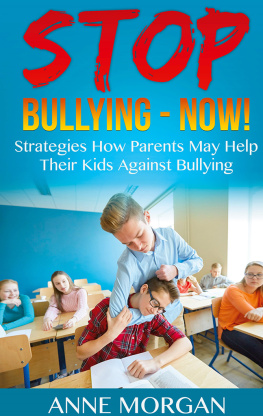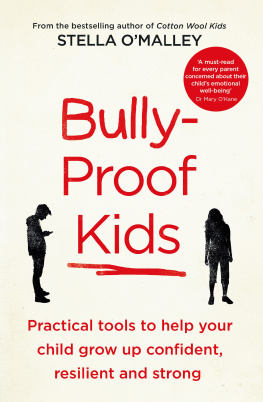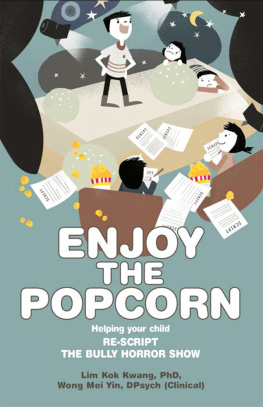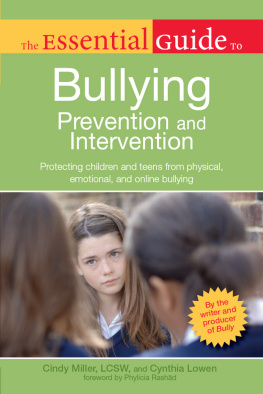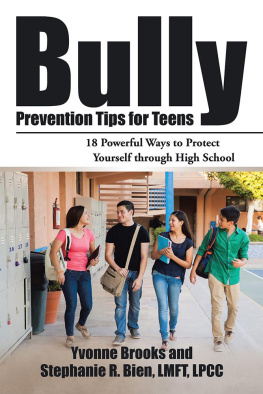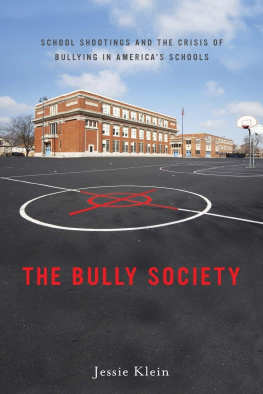BULLY SECOND EDITION
PREVENTION
BULLY SECOND EDITION
PREVENTION
Tips and Strategies for School Leaders
and Classroom Teachers
ELIZABETH A. BARTON

Copyright 2006 by Corwin Press, Inc.
All rights reserved. When forms and sample documents are included, their use is authorized only by educators, local school sites, and/or noncommercial or nonprofit entities who have purchased the book. Except for that usage, no part of this book may be reproduced or utilized in any form or by any means, electronic or mechanical, including photocopying, recording, or by any information storage and retrieval system, without permission in writing from the publisher.
For information:
 | Corwin Press, Inc.
A Sage Publications Company
2455 Teller Road
Thousand Oaks, California 91320
www.corwinpress.com
|
Sage Publications Ltd.
1 Olivers Yard
55 City Road
London EC1Y 1SP
United Kingdom
|
Sage Publications India Pvt. Ltd.
B-42, Panchsheel Enclave
Post Box 4109
New Delhi 110 017 India |
Printed in the United States of America.
This book is printed on acid-free paper.
Library of Congress Cataloging-in-Publication Data
Barton, Elizabeth A. Bully prevention: tips and strategies for school leaders and classroom teachers / Elizabeth A. Barton.2nd ed.
p. cm.
Includes bibliographical references and index.
ISBN 1-4129-3917-8 (cloth) ISBN 1-4129-3918-6 (pbk.)
1. Bullying in schoolsPrevention. 2. BullyingPrevention.
3. School violence. 4. Aggressiveness in children. I. Title.
LB3013.3.B37 2006
371.58dc22
2005037815
06 07 08 09 10 10 9 8 7 6 5 4 3 2 1
| Acquisitions Editor: | Cathy Hernandez |
| Editorial Assistant: | Charline Wu |
| Project Editor: | Kate Peterson |
| Copy Editor: | Pam Suwinsky |
| Typesetter: | C&M Digitals (P) Ltd. |
| Indexer: | Naomi Linzer |
| Cover Designer: | Rose Storey |
Contents
Preface
The Issue of Bullying and School Safety
I ncreasingly, school administrators and faculty are faced with the new responsibility of creating safer schools, in addition to their traditional mission of developing academic goals and helping children reach them. Pervasive bullying in schoolyards, classrooms, and hallways interferes with perceived school safety and directly impacts student learning outcomes.
Recent studies have indicated that children today are often afraid to attend school. DeVoe and Kaffenberger (2005) reported that bullied students were more likely than nonbullied students to skip school because they thought someone might attack or harm them. Once in school, researchers cite that victims often have difficulty concentrating on schoolwork and therefore are often at risk for poor performance and ultimately school truancy or dropout. DeVoe and Kaffenberger reported that bullied students were most likely to report receiving Ds and Fs than their nonbullied counterparts. In this same study, about 4 percent of students between 12 and 18 years old carried a weapon to school for protection.
In addition, a potential relationship exists between bullying and violence in school. Research suggests that being victimized by bullying may be an antecedent to aggressive behavior (Nansel, Overpeck, et al., 2001). In 2001, the Secret Service released its comprehensive report on youth violence in schools, exposing the possibility that violent youth involved in school shootings (for example, Littleton, Colorado, and Pearl, Mississippi) share a common thread: being victims of bullying in school (Vossekuil, Fein, Reddy, Borum, & Modzeleski, 2002).
School leaders and classroom teachers have multiple reasons for addressing bullying behaviors in school. Although the threat of violence and desire for academic success are significant reasons for anti-bullying efforts, teachers and school administrators should feel compelled to intervene in bullying episodes, as it is their duty and obligation to build inclusive classroom environments for all students.
ANTI-BULLYING PROGRAMMING WITHIN A SAFE SCHOOL CONTEXT
Anti-bullying programming, like other conflict resolution education, emphasizes developing students social skills and their ability to collaborate during conflict situations. Researchers have found that developing childrens social skills has a positive impact on academic achievement, particularly with at-risk children (Johnson & Johnson, 1995b). Hence, support for social skills programming in the school is key to further developing childrens cognitive capabilities in the classroom.
Education programming targeting anti-bullying has been successful in isolation in countries such as Great Britain. However, much of the work has focused on reducing bullying behaviors and not on developing the social skills of victims or changing the behavior of witnesses. Anti-bullying programming has often been viewed as a separate social skills training program rather than a piece of building safer schools. Anti-bullying programming is an integral component for building safer schools. As such, it should always be combined and consistent with other whole school approaches such as character education, specific conflict resolution programs (for example, peer mediation), and diversity education programming. The whole school approach to programming and policy will afford the school and its students the opportunity to drive organizational change so that students feel safer in the hallways and classrooms of their schools.
Bullying is not a new phenomenon or specific to the United States. The vision of the big, strong, and popular bully overpowering the weak, scrawny, and unpopular child has long been part of mainstream American culture. As adults, we vividly recall the bully-victim relationships of our childhood classrooms and neighborhoods. Europe and Scandinavia clearly identify bullying behavior as problematic for both youth and adults and have developed prevention, intervention, and public policy to ensure that bullying does not result in tragic acts of violence. Great Britain and Norway have included bully prevention in their interpretation of dictates of the United Nations Rights of the Child, which ensures the safety and welfare of all children. They consider the prevention of bullying behaviors an important component in building safer school communities.
We in the United States should join other countries in viewing bully prevention as a necessary component of safe school planning. Many schools already participate in crisis response planning and conflict resolution education. They should now consider including social skills training programs, staff development programs, and school policies on bullying behaviors to create the safest learning environment for all students.
ORGANIZATION OF THE BOOK
This book is intended to provide school leaders and K12 classroom teachers with practical strategies and information to develop, implement, and evaluate bully prevention and intervention programs. It provides a foundation for understanding the bully-victim relationship, outlines potential origins of these behaviors, and provides applications and mechanisms for building schoolwide and classroom anti-bullying programs.
, The Bully, Victim, and Witness Relationship Defined, outlines these relationships and explains how conflict and aggression play a role in bullying. Trends among bullies and victims, and the long-term effects of these relationships, are discussed to emphasize the importance of prevention and intervention in classroom and school settings.
Next page

